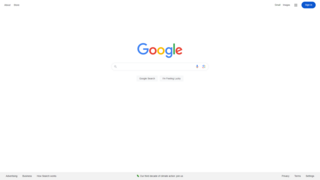Related Research Articles

Google Search is a search engine operated by Google. It allows users to search for information on the Web by entering keywords or phrases. Google Search uses algorithms to analyze and rank websites based on their relevance to the search query. It is the most popular search engine worldwide.

A blog is an informational website consisting of discrete, often informal diary-style text entries (posts). Posts are typically displayed in reverse chronological order so that the most recent post appears first, at the top of the web page. In the 2000s, blogs were often the work of a single individual, occasionally of a small group, and often covered a single subject or topic. In the 2010s, "multi-author blogs" (MABs) emerged, featuring the writing of multiple authors and sometimes professionally edited. MABs from newspapers, other media outlets, universities, think tanks, advocacy groups, and similar institutions account for an increasing quantity of blog traffic. The rise of Twitter and other "microblogging" systems helps integrate MABs and single-author blogs into the news media. Blog can also be used as a verb, meaning to maintain or add content to a blog.

The terms Google bombing and Google washing refer to the practice of causing a website to rank highly in web search engine results for irrelevant, unrelated or off-topic search terms by linking heavily. In contrast, search engine optimization (SEO) is the practice of improving the search engine listings of web pages for relevant search terms.
The blogosphere is made up of all blogs and their interconnections. The term implies that blogs exist together as a connected community or as a social networking service in which everyday authors can publish their opinions and views.
Nielsen Holdings plc is an American media audience measurement firm. Nielsen operates in over 100 countries and employs approximately 15,000 people worldwide.
This is a list of blogging terms. Blogging, like any hobby, has developed something of a specialized vocabulary. The following is an attempt to explain a few of the more common phrases and words, including etymologies when not obvious.
Google Trends is a website by Google that analyzes the popularity of top search queries in Google Search across various regions and languages. The website uses graphs to compare the search volume of different queries over time.
Google Programmable Search Engine is a platform provided by Google that allows web developers to feature specialized information in web searches, refine and categorize queries and create customized search engines, based on Google Search. Google launched the service on October 23, 2006.
Social media optimization (SMO) is the use of online platforms to generate income or publicity to increase the awareness of a brand, event, product or service. Types of social media involved include RSS feeds, blogging sites, social bookmarking sites, social news websites, video sharing websites such as Youtube and social networking sites such as Facebook, Instagram, Tiktok and X(Twitter). SMO is similar to search engine optimization (SEO) in that the goal is to drive web traffic, and draw attention to a company or creator. SMO's focal point is on gaining organic links to social media content. In contrast, SEO's core is about reaching the top of the search engine hierarchy. In general, social media optimization refers to optimizing a website and its content to encourage more users to use and share links to the website across social media and networking sites.
Fashion blogs are blogs that cover the fashion industry, clothing, and lifestyle related topics.
Marketing buzz or simply buzz—a term used in viral marketing—is the interaction of consumers and users with a product or service which amplifies or alters the original marketing message. This emotion, energy, excitement, or anticipation about a product or service can be positive or negative. Buzz can be generated by intentional marketing activities by the brand owner or it can be the result of an independent event that enters public awareness through social or traditional media such as newspapers. Marketing buzz originally referred to oral communication but in the age of Web 2.0, social media such as Facebook, Twitter, Instagram and YouTube are now the dominant communication channels for marketing buzz.
Twitoaster was a Twitter web application that threaded and archived users' conversations in real time. It was often used by journalists, bloggers or companies who need to collect, organize and keep a track of their Twitter mentions.
BackType was a SaaS social media analytics service launched in August 2008.

Google+ was a social network that was owned and operated by Google until it ceased operations in 2019. The network was launched on June 28, 2011, in an attempt to challenge other social networks, linking other Google products like Google Drive, Blogger and YouTube. The service, Google's fourth foray into social networking, experienced strong growth in its initial years, although usage statistics varied, depending on how the service was defined. Three Google executives oversaw the service, which underwent substantial changes that led to a redesign in November 2015.
Regator.com was a curated blog directory and search engine. Founded in 2007 by Scott Lockhart, Chris Turner, and Kimberly Turner and going live with Regator.com in August 2008, Regator LLC also produces Regator Breaking News and the Regator iPhone App for iOS. The API platform also allows for detailed trend tracking and analyzing text. The Breaking News app regularly breaks stories faster than news outlets such as CNN, FoxNews.com, the Huffington Post, and Twitter trending topics.

JamiQ Private Limited is a Singapore-based social media monitoring company. The company was founded by Kelvin Quee, Lee Jia Yi, and Benjamin Koe in September 2008, initially incubated with NTU Ventures. JamiQ's software uses algorithms that can understand the opinions and feelings inferred from phrases and sentences. It processes English words and denotes a positive or negative value to them. JamiQ's software also uses search engines, APIs, RSS feeds, and web crawlers to monitor social media in real-time. It specializes in monitoring Asian social media.

Facebook Graph Search was a semantic search engine that Facebook introduced in March 2013. It was designed to give answers to user natural language queries rather than a list of links. The name refers to the social graph nature of Facebook, which maps the relationships among users. The Graph Search feature combined the big data acquired from its over one billion users and external data into a search engine providing user-specific search results. In a presentation headed by Facebook CEO Mark Zuckerberg, it was announced that the Graph Search algorithm finds information from within a user's network of friends. Microsoft's Bing search engine provided additional results. In July it was made available to all users using the U.S. English version of Facebook. After being made less publicly visible starting December 2014, the original Graph Search was almost entirely deprecated in June 2019.

Topsy Labs was a social search and analytics company based in San Francisco, California. The company was a certified Twitter partner and maintained a comprehensive index of tweets, numbering in the hundreds of billions, dating back to Twitter's inception in 2006.

NewsWhip is a social media engagement tracking firm created by Paul Quigley and Andrew Mullaney in 2011. The company tracks content by amount and location of user engagement and also tracks audience interests and changes in interests over time.
References
- ↑ Price, Gary (17 January 2006). "Buzzmetrics and Intelliseek Join Forces and then Merge with Nielsen" . Retrieved 5 August 2011.
- ↑ Cohen, David. "Nielsen, McKinsey Target Social Media with NM Incite Joint Venture" . Retrieved 5 August 2011.
- ↑ "Farewell To BlogPulse | SmartData Collective". smartdatacollective.com. Archived from the original on 2012-01-22.
- ↑ Sherman, Chris (20 July 2005). "Deeper Insight into the Blogosphere" . Retrieved 5 August 2011.
- ↑ Ragas, Matt. "Review of BlogPulse". Archived from the original on 28 March 2012. Retrieved 5 August 2011.